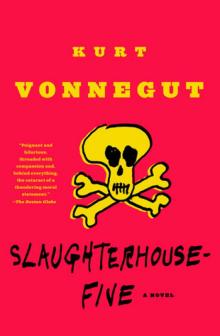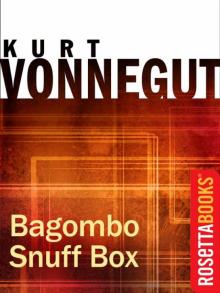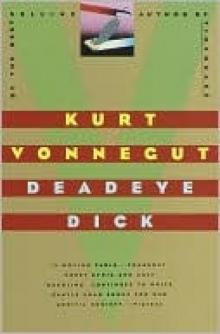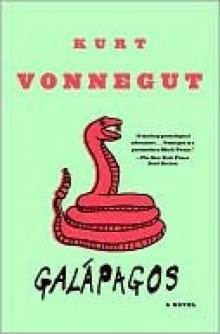- Home
- Kurt Vonnegut
Fates Worse Than Death: An Autobiographical Collage (Kurt Vonnegut Series) Page 9
Fates Worse Than Death: An Autobiographical Collage (Kurt Vonnegut Series) Read online
Page 9
Back to Bernard V. O’Hare again:
One of the several laudatory obituaries he received in newspapers in Northampton County, Pennsylvania, said (far down in the story), “Along with author Kurt Vonnegut, with whom he trained, he was imprisoned in Dresden when it was fire-bombed.” (One obituary called him “one of the most admired and colorful attorneys in Northampton County,” and another called him “feisty.”) About a month before he died, I spoke about the firebombing at the National Air and Space Museum in Washington, D.C. Mine was one of a series of lectures entitled “The Legacy of Strategic Bombing,” and it began as follows:
“It isn’t usual for a speech to begin with a disclaimer. The first rule of public speaking is ‘Never apologize.’
“In my case, though, since I have been asked to speak about the firebombing of a German city, and my name is obviously German in origin, it seems prudent to say that I was and remain unsympathetic to the enthusiasms of the Nazi war machine, as was my commanding general, another German-American, Dwight David Eisenhower. His German ancestors and mine became Americans decades before the Statue of Liberty was erected in New York Harbor.
“I was a battalion scout, a PFC, who was captured on the border of Germany in December 1944 during the Battle of the Bulge. Thus did I happen to be a laborer under guard in Dresden when it was firebombed on February 13, 1945. The Germans were in full retreat on all fronts and surrendering in ever greater numbers, and had few airplanes left, and every German city but Dresden had been bombed and bombed. The war would end soon, on May 7.
“When I was liberated in May, I was in the Russian zone. I spent some time with concentration camp survivors and heard their stories before returning to the American lines. I have since visited Auschwitz and Birkenau and have seen the collections there of human hair and children’s shoes and toys and so on. I know about the Holocaust. Elie Wiesel and I are friends.
“The principal reason for this disclaimer is an assertion by that A-plus student, the heavy thinker George Will, that I trivialized the Holocaust with my novel Slaughterhouse-Five. I find that most unhelpful, and I hope you do, too.
“There is no dearth of persons who could tell you what it is like to be unarmed in a mainly civilian population bombed or rocketed or whatever from the air. There are surely millions of us by now. The most recent initiates into our enormous club are in some of the poorer neighborhoods of Panama City. Cambodians and Vietnamese are senior members now.
“How many people in this very room here, in fact, have, while not in combat, been attacked from the air? (About twelve.)
“The firebombing of Dresden was mainly a British enterprise. Americans, several of whom I have since met, dropped high explosives in the daytime to make kindling for the thousands of incendiaries to come. The British came that night with the incendiaries. Their target? The whole city. It was hard to miss. And the city became one flame, with tornadoes dancing in the suburbs like whirling dervishes. The man who interviewed me for admission to the University of Chicago after the war was one of the Americans who attacked in the daytime, virtually unopposed. He said, ‘We hated to do it.’
“Most of the British, I think, felt otherwise. They wanted revenge for the London blitz and the leveling of Coventry and the humiliation at Dunkirk and so on. The Americans had no scores to settle. They might have felt vengeful if they had known the incredible extent of the horrors of the German death camps, but that hadn’t been discovered yet by the outside world.
“What Americans had to avenge was Pearl Harbor. They would do that, with no help from the British, in their own sweet time. Like the British, they would do it when the war was already clearly won.
“The total destruction of Hiroshima, a racist atrocity of atrocities, nonetheless had military significance. When I was in Tokyo with William Styron a few years ago, he said, ‘Thank God for the atomic bomb. If it weren’t for it, I would be dead.’ When the bomb dropped, he was a Marine in Okinawa, preparing for the invasion of the Japanese home islands. It seems certain to me that many more Americans and Japanese would have died during the invasion than were burned to crisps at Hiroshima.
“The firebombing of Dresden was an emotional event without a trace of military importance. The Germans purposely kept the city free of major war industries and arsenals and troop concentrations so that it might be a safe haven for the wounded and refugees. There were no air-raid shelters to speak of and few antiaircraft guns. It was a famous world art treasure, like Paris or Vienna or Prague, and about as sinister as a wedding cake. I will say again what I have often said in print and in speeches, that not one Allied soldier was able to advance as much as an inch because of the firebombing of Dresden. Not one prisoner of the Nazis got out of prison a microsecond earlier. Only one person on earth clearly benefited, and I am that person. I got about five dollars for each corpse, counting my fee tonight.
“Nobody ever argues with me very plausibly or very long when I say that, and I’ve said it not only here but in Britain and France and Scandinavia and Poland and Czechoslovakia and Germany. I may have said it in Mexico. I can’t remember whether or not I’ve ever said it in Mexico.
“Paradoxically, I am not only the one success of the raid but also one of its thousands of failures. Everything possible was done to make me die, but I did not die. It wasn’t as though the bombardiers knew where I was and were careful not to hurt me. They didn’t know or care who was what or where. The leaders of their nations hoped they would burn down the city and kill as many people of any sort as they could with fire or smoke or lack of oxygen, or some combination of the three.
“Same scheme as Hiroshima, but with primitive technology, and with white people down below.
“I fully understand the bombardiers’ lack of discrimination as to who or what was underneath them. They had a point: Whoever was down there, whether by actively supporting Hitler or simply failing to overthrow him, was directly or indirectly playing a part, however small, in Nazi crimes against humanity. I, and the ninety-nine other American privates in my particular labor detail there in Dresden, were working in a factory that made a malt syrup laced with vitamins which was for pregnant women, who would give birth to more heartless warriors. At least we weren’t volunteers. We were forced to work for our keep under guard, as specified by the Articles of the Geneva Convention Respecting Prisoners of War. If we had been noncoms or officers, we wouldn’t have had to work and would have been not in Dresden but in some big prison out in the countryside.
“I have said that I have so far received about five bucks for every corpse created by the firestorm. But this is a ballpark figure if there ever was one. It will never be known how many corpses there were or what sorts of souls may have inhabited them. I have heard every number from 35,000 to 200,000. The highest and lowest estimates are politically motivated, minimizing or maximizing the viciousness of the raid. The number which sounds right to me, and the one most often heard from people with no axes to grind, is 135,000, more than were killed in Hiroshima. But the population of Dresden at the time of the raid was a mystery, since so many refugees from the collapsing Russian Front and other bombed cities were arriving day after day.
“After the raid, the corpses, most of them in ordinary cellars, were so numerous and represented such a health hazard that they were cremated on huge funeral pyres, or by flamethrowers whose nozzles were thrust into the cellars, without being counted or identified. Many friends and relatives of refugees newly arrived in Dresden can say of them nowadays only that they somehow disappeared near the end of World War II. The town was full of Polish slave laborers. Their friends and relatives must be saying of them nowadays simply that they were taken off to Germany somewhere and never came home again.
“This much can be said about Dresden’s population with some certainty: There were few remotely able-bodied males between the ages of sixteen and fifty. Such specimens were all fighting or surrendering or dying or deserting somewhere else. The great German writer Günter Grass, who was
a boy during World War II, asked me one time in what year I was born. I told him 1922. He said that there were no males my age still alive in Germany, Austria, or the Soviet Union. That was only a slight exaggeration.
“Among the unidentified, not-even-counted dead in the cellars of Dresden there were, without doubt, war criminals or loathsomely proud relatives of war criminals, SS and Gestapo, and so on. Whatever they got was too good for them. Maybe most of the Germans killed in Dresden, excepting the infants and children, of course, got what was coming to them. I asked another great German writer, Heinrich Böll, what he thought the dangerous flaw in the character of so many Germans was, and he said, ‘Obedience.’
“But I have to say that I felt no pride or satisfaction while carrying corpses from cellars to great funeral pyres while friends and relatives of the missing watched. They may have thought that it served me right to do such gruesome work at gunpoint, since it was my side in the war which had made it a necessity. But who knows what they thought? Their minds may have been blank. I know mine was.
“And it was all such one hell of a long time ago. Forty-five years.
“The firebombing of Dresden, which had no military significance, was a work of art. It was a tower of smoke and flame to commemorate the rage and heartbreak of so many who had had their lives warped or ruined by the indescribable greed and vanity and cruelty of Germany. The British and Americans who built the tower had been raised, like me, and in response to World War I, to be pacifists.
“Two more such towers would be built by Americans alone in Japan. When they were built and then blew away, leaving nothing but ashes and cinders, I was on furlough in Indianapolis, my home. And even though I had seen on the ground the effects of a similar total conflagration, I myself regarded those twin towers as works of art. Beautiful!
“That was how crazy I had become. That is how crazy we had all become.
“That is how crazy we remain today. Attacking a civilian population from the air, with or without warning, with or without a declaration of war, has become for most of us simply one more symbol, like the Liberty Bell, of national pride.
“Who would be so chicken-hearted as to say that the killing from the air of Muammar Qaddafi’s adopted daughter, as well intentioned as my own adopted daughter, was a serious matter, or even interesting? Not The New York Times. Not The Washington Post. Not MacNeil or Lehrer or Brokaw or Rather or Jennings. And not me.
“We also zapped the French Embassy.
“Henry Kissinger, winner of the Nobel Peace Prize, who recommended that Hanoi be carpet-bombed at Christmastime, is considered a grave, humane, wise diplomat. I think so, too.
“Albert Schweitzer, a physician as well as a musician and a philosopher, hoped to teach us reverence for life. He felt that we should not kill even the tiniest, most contemptible organism if we could possibly avoid doing that. On the face of it, this ideal is preposterous, since so many diseases are caused by germs. Dr. Schweitzer himself must have killed germs by the billions. Either that, or most of his patients died.
“If I were to speak tonight of the agony experienced by individual germs in the bodies of patients dosed by Dr. Schweitzer, the men in white coats would be entitled to cart me off to St. Elizabeths. And our frame of mind now, not just in this country but in many, many others, including, no doubt, Libya, is such that civilians attacked from the air are as unworthy of being discussed as individual germs.
“Many people find my speeches, and probably my books, too, hopelessly ambiguous. But I don’t want to leave you feeling unfed. So let me throw these big chunks of beefsteak into your stew, so to speak, and speaking as a cold-blooded Commander in Chief:
“Should Dresden have been firebombed? No.
“Should Hamburg have been bombed and bombed? Yes.
“Should Hiroshima have been bombed? Ask all those who would have been dead otherwise.
“Should Nagasaki have been bombed? No.
“Should Hanoi’s civilian population have been bombed and bombed? No.
“Should any part of Cambodia have been bombed? No.
“Should Libya have been attacked from the air? No. That was show biz.
“Should Panama City have been bombed? No. That was more show biz.
“I thank you for your attention.”
There was no press coverage of my wonderful remarks, although their auspices were reputable. (I don’t whimper about this. I notice.) I was well-known. The National Air and Space Museum was well-known. The firebombing of Dresden was well-known. In combination, you would think, some reporter might have found us interesting. Another American ex-PW who was in Dresden with me and O’Hare showed up unexpectedly, and testified from the audience that all I said was true. And my adopted seven-year-old daughter Lily was sitting near him with my wife Jill. I had Lily stand up on her seat as an approximation of the sort of germ Muammar Qaddafi’s adopted daughter had been before we killed her with the very latest in air-to-ground weapons technology. Some people might argue that my equation was misleading, since Qaddafi’s kid was an infant and mine would soon be eight years old.
We got no press coverage, in my opinion (although there was an overflow audience in the lobby watching on TV screens) because in Washington, D.C., citizens who say that our air power has been or ever could be misused are regarded by those who decide what is news and what isn’t as politically immature, like a lot of college kids and unlike Dr. Henry Kissinger, Nobel Laureate for Peace. When all is said and done, we are simpleminded creatures, glad to believe on the basis of symbolism alone (up is better than down) that air superiority is moral superiority. (After all, look where God lives. He isn’t in some ditch like the Vietnam Veterans Memorial.) What can I accomplish but a decrease in American happiness if I say to a crowd, as I did, that an attack on a civilian population by clean, decent young men in enormously expensive and complex flying machines is, when viewed from the ground, no different from the practice of the world’s worst police departments, which is to make arrested nobodies watch the torture of innocent friends and relatives, young and old, with the intention of changing the nobodies’ probable politics?
A woman said to me after my speech, “Nobody should ever be bombed.”
I replied, “Nothing could be more obvious.”
XI
The fellow ex-Dresden PW at my National Air and Space Museum lecture was Tom Jones, who had paired off (as ordered) in his 106th Division platoon with Joe Crone, the model for Billy Pilgrim, the leading character in Slaughterhouse-Five. Jones said, in a letter I got only yesterday, “I remember Crone in Camp Atterbury. When we went on a forced march I had to walk behind him and pick up all the utensils falling out of his backpack. He could never do it right.
“I bunked with him when he died. One morning he woke up and his head was swollen like a watermelon and I talked him into going on sick call. By midday word came back that he had died. You remember we slept two in a bunk so I had to shake Crone several times a night and say, ‘Let’s turn over.’ I recall how in the early morning hours the slop cans at the end of the barracks overflowed. Everyone had the shits, and it flowed down the barracks under everyone’s bunk. The Germans never would give us more cans.”
Joe Crone is buried somewhere in Dresden wearing a white paper suit. He let himself starve to death before the firestorm. In Slaughterhouse-Five I have him return home to become a fabulously well-to-do optometrist. (Jones and Crone were stockpiled college kids like O’Hare and me. We all read a lot at Camp Atterbury.)
Jones, there in Washington, D.C., turned out to have been quite a packrat when it came to wartime memorabilia. He had a copy of a letter given to us by the Germans which urged us to join their army (and get plenty to eat) and go fight for civilization on the Russian Front. (Rumor was that five Americans somewhere else had accepted the offer. If those five didn’t exist we would still have had to invent them.) Tom Jones had photographs of several of us, including O’Hare (but not Joe Crone, not Billy Pilgrim), taken right after the war
ended. Our guards had disappeared, and the Russian Army had not yet arrived, and we found ourselves in the valley I describe at the end of my novel Bluebeard (called Bluebird in the meticulously edited New York Times). We came upon a German Army wagon with horse still attached and made it ours. We painted white American stars on its sides and “USA” on its tailgate, so the Russian fighter planes overhead wouldn’t shoot at us. We traveled that way for several days until the Russian ground troops finally arrived and locked us up again.
Another thing I have put into the Appendix was handed me by a stranger in the audience. It is from a “Bomber’s Baedeker” from World War II. It tells you where (the choice is yours) you might want to drop bombs if for one reason or another you have some or all of them left over from that day’s or night’s mission. (Waste not, want not.) The donor of the document (obviously another chicken-hearted person) wanted me to confirm what I could only assert up to then: that Dresden was no more a military target than Kalamazoo, Michigan, is today. There is a lot of stuff in Kalamazoo. There was a lot of stuff in Dresden, businesses and forms of transportation and police stations and facilities for generating electricity and giving birth to potential soldiers and nurses and so on. (Bombs away!) There was a zoo in Dresden for the entertainment of potential soldiers and nurses. The Baedeker for Bombers missed that one, but the bombs didn’t. You should have seen the giraffe after the firestorm. (I did.)
During the question-and-answer period following my great speech I found an opportunity to quote O’Hare. When a Liberty Ship (the Lucretia C. Mott, named for a women’s rights advocate) had wallowed us back to the United States through severe storms in the North Atlantic, and it was time for me and my buddy to say good-bye for a while (a condition now quite permanent), I said to him, “What did you learn?” The future DA O’Hare replied, “I will never again believe my Government.” This had to do with our Government’s tall tales of delicate surgery performed by bombers equipped with Sperry and Norden bombsights. These instruments were so precise, we had been told, that a bombardier could drop his billets-doux down the chimney of a factory if ordered to. There were solemn charades performed for newsreels in which military policemen with drawn .45 automatics escorted bombardiers carrying bombsights to their planes. That was how desperate the Germans and the Japanese were (so went the message) to learn and make use of the secret of our bombings’ diabolical accuracy themselves.

 Slaughterhouse-Five
Slaughterhouse-Five Bagombo Snuff Box: Uncollected Short Fiction
Bagombo Snuff Box: Uncollected Short Fiction God Bless You, Dr. Kevorkian
God Bless You, Dr. Kevorkian Breakfast of Champions
Breakfast of Champions While Mortals Sleep: Unpublished Short Fiction
While Mortals Sleep: Unpublished Short Fiction Slapstick or Lonesome No More!
Slapstick or Lonesome No More! Cat's Cradle
Cat's Cradle The Sirens of Titan
The Sirens of Titan A Man Without a Country
A Man Without a Country Look at the Birdie: Unpublished Short Fiction
Look at the Birdie: Unpublished Short Fiction Bluebeard
Bluebeard Hocus Pocus
Hocus Pocus The Big Trip Up Yonder
The Big Trip Up Yonder Palm Sunday: An Autobiographical Collage
Palm Sunday: An Autobiographical Collage Jailbird
Jailbird Happy Birthday, Wanda June
Happy Birthday, Wanda June Welcome to the Monkey House
Welcome to the Monkey House Player Piano
Player Piano Fates Worse Than Death: An Autobiographical Collage
Fates Worse Than Death: An Autobiographical Collage Love, Kurt
Love, Kurt Timequake
Timequake God Bless You, Mr. Rosewater
God Bless You, Mr. Rosewater 2 B R 0 2 B
2 B R 0 2 B The Eden Express: A Memoir of Insanity
The Eden Express: A Memoir of Insanity Mother Night
Mother Night Deadeye Dick
Deadeye Dick Galápagos
Galápagos Palm Sunday
Palm Sunday We Are What We Pretend to Be
We Are What We Pretend to Be Look at the Birdie
Look at the Birdie Basic Training
Basic Training Armageddon in Retrospect
Armageddon in Retrospect Basic Training (Kindle Single)
Basic Training (Kindle Single) If This Isn't Nice, What Is?
If This Isn't Nice, What Is? Bagombo Snuff Box
Bagombo Snuff Box The Petrified Ants
The Petrified Ants Cat's Cradle: A Novel
Cat's Cradle: A Novel Fates Worse Than Death: An Autobiographical Collage (Kurt Vonnegut Series)
Fates Worse Than Death: An Autobiographical Collage (Kurt Vonnegut Series)